ACR Electronics ACRPLB-400-425 Personal Locator Beacon User Manual
ACR Electronics, Inc. Personal Locator Beacon Users Manual
Users Manual
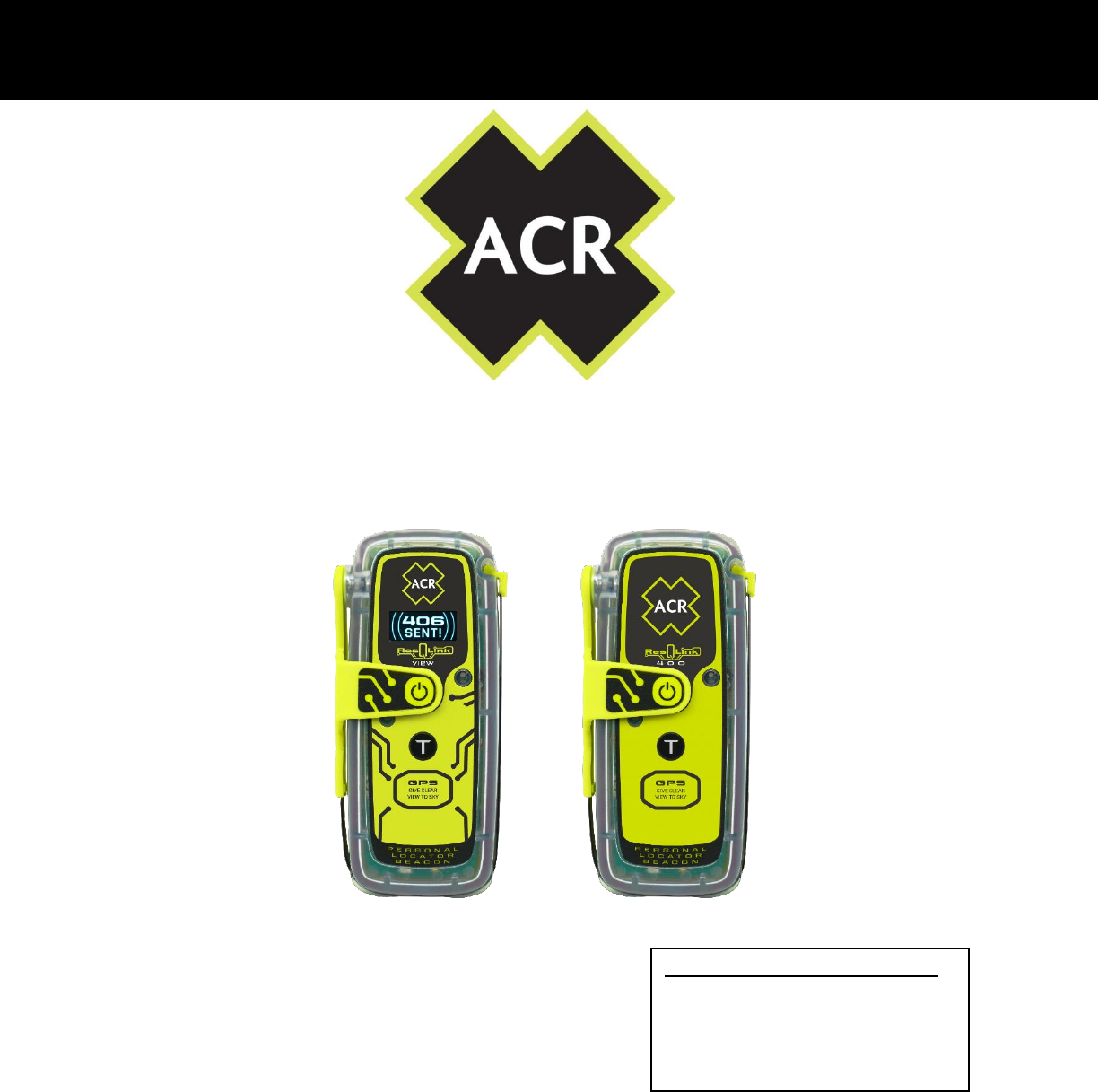
ResQLink™ 400 & ResQLink™ View
406 MHz Personal Locator Beacons
Product User Manual
Y1-03-0343 Rev. T1
Models: PLB-400 & PLB-425
Part Numbers: 2921 & 2922
THE SCIENCE OF SURVIVAL
Name of Owner/Organization:

Y1-03-0343 Rev. T1 Company Confidential 2
ACR Electronics, Inc.
5757 Ravenswood Road, Fort Lauderdale, FL 33312
Phone (954) 981-3333, Fax (954) 983-5087
www.acrartex.com
Table of Contents
Beacon (406MHz) Registration
4
Anatomy of a Rescue
7
Anatomy of Your Beacon
8
Activating Your Beacon
10
User Interface: Digital Display during Operation
13
Turning Your Beacon Off
14
Testing Your Beacon – Self-Test
15
User Interface: Digital Display during Self-Test
16
Testing Your Beacon – GPS/GNSS Self-Test
17
User Interface: Digital Display during GPS/GNSS
Test
18
Satellite Testing Your Beacon
19
False Alarms
19
Beacon Maintenance
20
Product Specifications
22
Product Warranty
25
This manual supports all configurations of PLB-400 and PLB-425 beacons. Depending on
country of registration, the beacon will have a unique country code identification in the
part number (for example, 2921.62 or 2922.64). As long as the first four digits are the
same as one of the part numbers on the cover, this manual is applicable. If you have
questions regarding the contents of this manual or something not covered in the

Y1-03-0343 Rev. T1 Company Confidential 3
manual, please contact our Technical Service Department at ACR Electronics, Inc. +1
(954) 862-2110.
Please read all Notes, Warnings and Cautions Carefully.
CAUTION:
Before proceeding to test or use your new ACR Electronics, Inc.
(ACR) product, please read this Product User Manual in its entirety.
WARNING:
The Personal Locator Beacon (PLB) must be promptly registered
with the appropriate National Authority. Failure to register the
beacon could delay a Search and Rescue (SAR) response and may
be unlawful.
WARNING:
This transmitter is authorized for use only during situations of grave
and imminent danger. Deliberate misuse may incur a severe
penalty.
WARNING:
CAUTION:
Notice to the public, do not move beacon if found, report position
to authorities
False alerts endanger lives and cause expensive disruption to
Search and Rescue services. Deliberate misuse of the beacon could
result in a penalty and fine.
CAUTION:
Do not dismantle the PLB. It contains no user-serviceable parts.
CAUTION:
Contains lithium batteries. Do not incinerate, puncture, deform,
short-circuit or recharge.
Disposal:
Remove the Lithium battery. Dispose of the used battery in
accordance with local waste disposal regulations.
Air Travel:
Product contains small lithium metal batteries that comply with
IATA SP 188-PI 970 Air Cargo. Always check with air carrier
concerns for any additional restrictions.
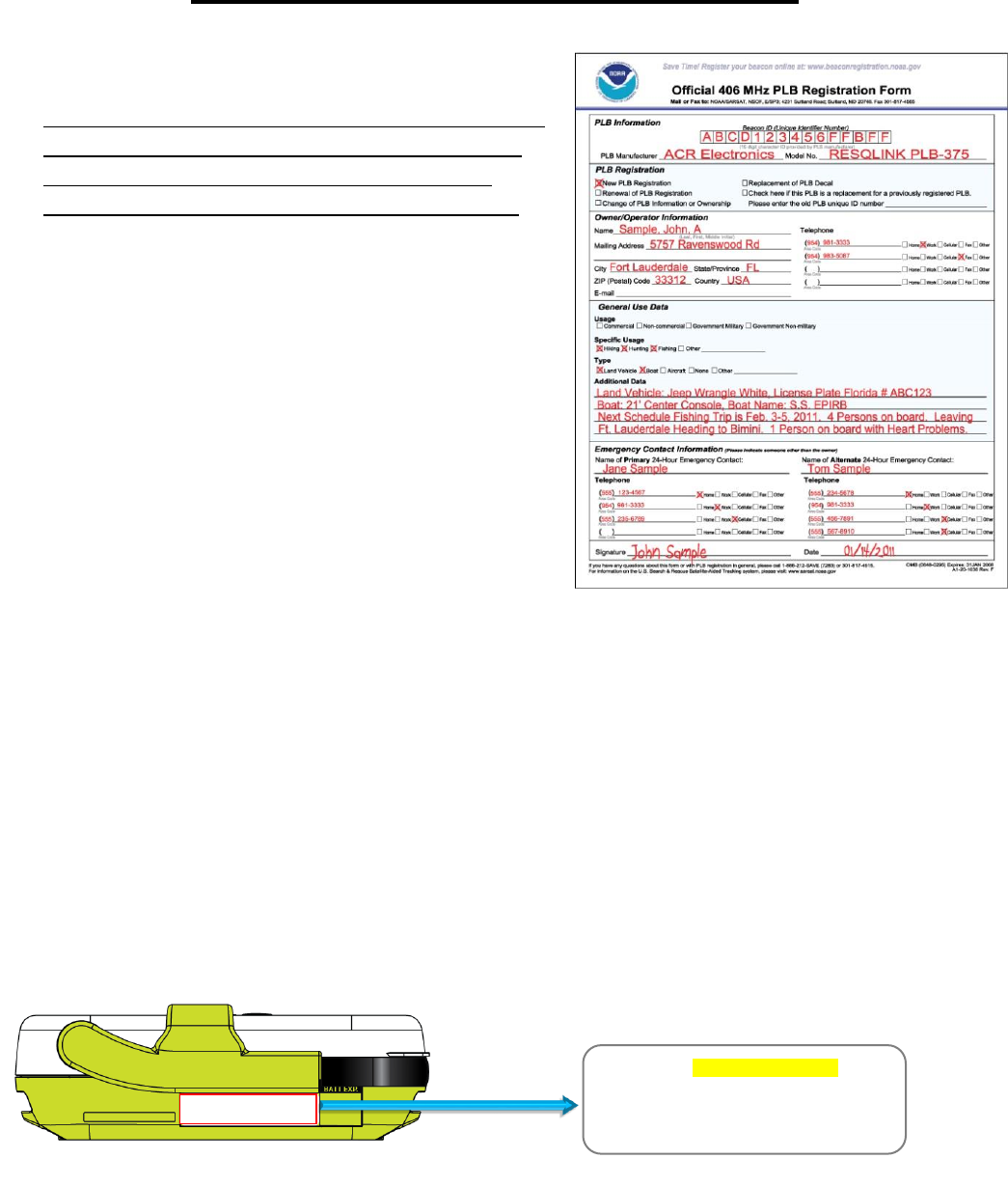
Y1-03-0343 Rev. T1 Company Confidential 4
Beacon (406 MHz) Registration
Registering Your Beacon
As the owner of this 406 MHz beacon, and due to the
global alerting nature of the Cospas-Sarsat satellite
system, it is a requirement that you register the
beacon with the National Authority of your country
(e.g. National Oceanic Atmospheric Administration in
the U.S., Australian Maritime Safety Authority in
Australia - online registration preferred in Australia -
and the Rescue Coordination Centre in New Zealand).
Please note that in many countries all 406 MHz
beacons are required to have their registration
updated every two years by the owner. Please check
the requirements for your country of registration.
How Registration Works
All 406 MHz beacons transmit a Unique Identifier
Number (UIN) when activated. The UIN is identified as
the 15 digit Hex ID on the beacon (see enlarged label image below for location of Hex ID on
your beacon). This Hex ID/UIN is programmed into the beacon based on the country in which
the beacon is registered, thus authorities are able to determine which country’s database will
have your registration information. Information provided during registration is used only for
rescue purposes and provides Search and Rescue forces with information as to who you are as
the owner of the beacon, the name and type of vessel that you have (if applicable), your
address, and who to contact that might know of your situation, but only if your beacon has
been properly registered.
Valuable search and rescue resources are wasted every year responding to false alerts. Please
register your beacon immediately to help resolve this issue of wasted resources.
C/S 15 HEX: A4CC3 3FFA44 FFBFF
MFG: MMM YY C/S TAC: XXX
Cntry: USA (XXX) – S/N: XXXXX
Model: PLB-XXX P/N: XXXX
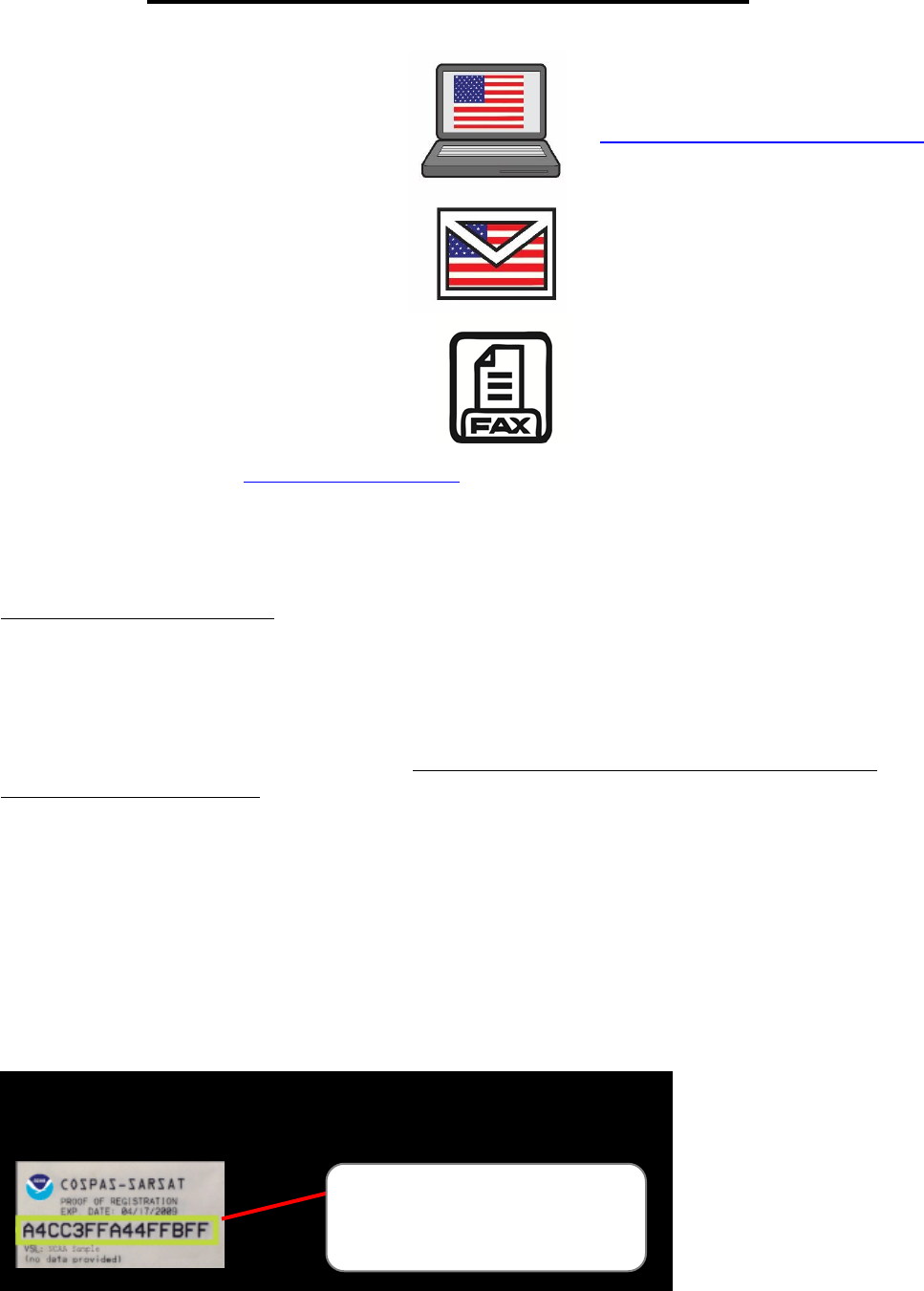
Y1-03-0343 Rev. T1 Company Confidential 5
User Tip
Beacon (406 MHz) Registration
What country should I register in? The
beacon must be registered in the country of
the owner’s residence. If the beacon is not
programmed to that country’s code and
protocol, and the residence is out of the USA,
the beacon needs to be reprogrammed.
Additionally, the beacon must be
reprogrammed if you, as the owner, move
out of the country where the beacon is
registered. To verify the country for which a
beacon is programmed, see the label with the
Unique Identification Number on the back of the
unit.
For a complete list of all countries with
registration information visit www.406registration.com
Please check to make sure that your PLB is registered correctly.
How do I register?
Registration in the United States – The national authority that accepts registrations in the United States is
the National Oceanic and Atmospheric Administration (NOAA). A NOAA registration form is included with
U.S. coded ACR PLBs (Australian coded ACR PLBs include a registration card and New Zealand coded ACR
PLBs include a registration form).
If not registering online, hard copies of registration forms will be entered in the 406 MHz beacon
registration database within 48 hours of receipt. The information you provide on the registration form is
used for rescue purposes only.
A confirmation letter, a copy of the registration, and a registration decal (see sample image on the left in
the “User Tip” window below) will be mailed to you within two weeks by NOAA. When you receive these
documents, please check the information carefully, and then affix the decal to your beacon in the area
marked “Place Beacon Decal Here.”
It is very important that the UIN on the registration decal matches the UIN on the beacon label (see
sample beacon label on the right and sample registration decal on the left in the “User Tip” window
below). If you do not receive your registration decal back from NOAA within two weeks, call this toll free
number (888) 212-7283 for assistance.
The fastest and easiest way to
register is online at:
www.beaconregistration.noaa.gov/
Or send the original, signed form
by mail to:
NOAA SARSAT Beacon
Registration
NSOF E/SPO53
1315 East West Hwy
Silver Spring, MD 20910-3282
Or fax form to :
301-817-4565
C/S 15 HEX: A4CC3 3FFA44 FFBFF
MFG: MMM YY C/S TAC: XXX
Cntry: USA (XXX) – S/N: XXXXX
Model: PLB-XXX P/N: XXXX
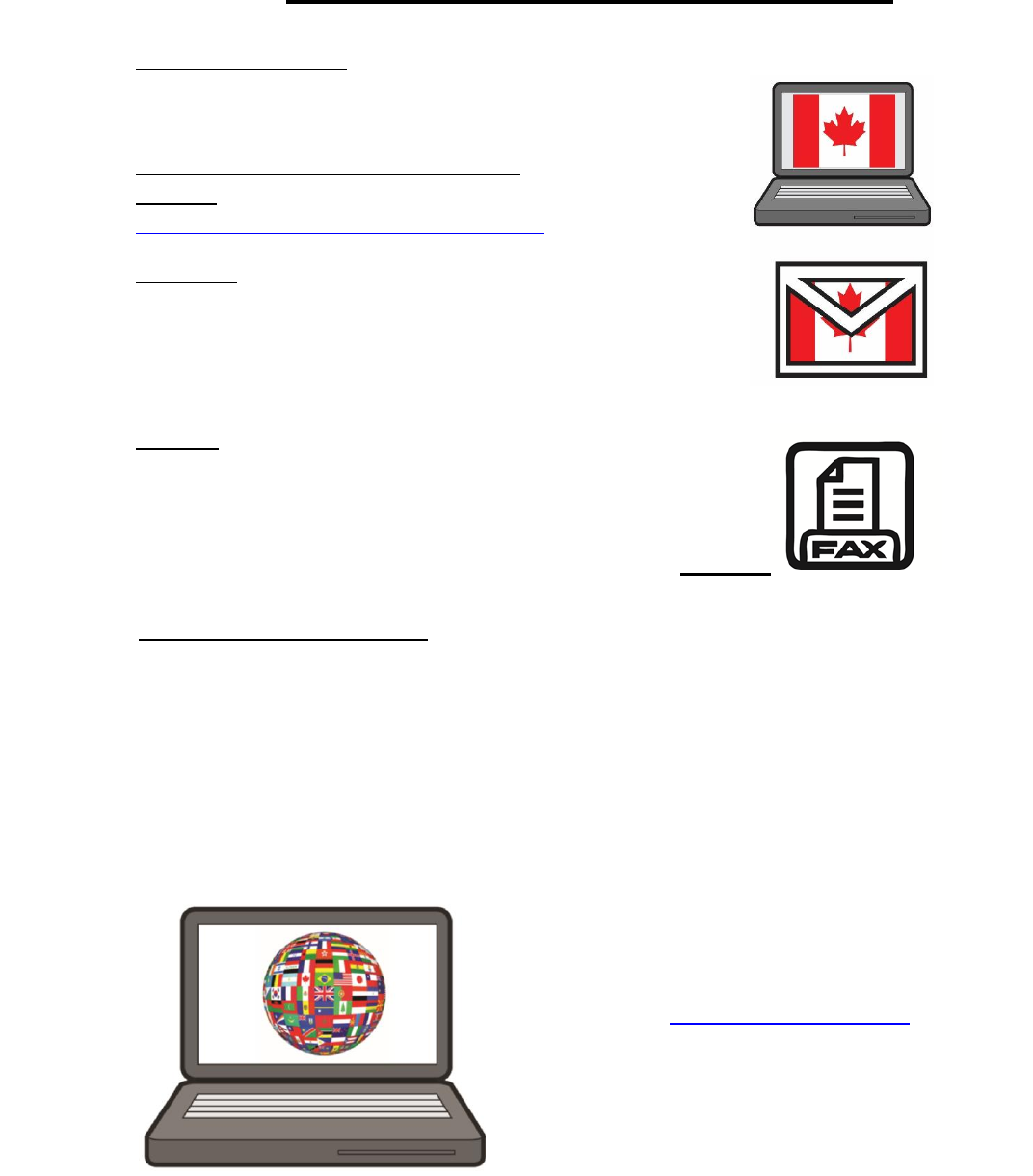
Y1-03-0343 Rev. T1 Company Confidential 6
Beacon (406 MHz) Registration
Registration in Other Countries
In countries other than the United States and Canada, 406 MHz beacons are registered with
that country’s national authority at the time of purchase. The sales agent may have assisted
you in filling out the forms and sending them to the country’s national authority.
To verify that the unit is properly programmed for your country, view the UIN label on the back
of the unit. In the event that the beacon is not programmed for your country, the sales agent
(if properly equipped) can reprogram the unit for the correct country.
Registration in Canada
Canadian registration form is included with
Canadian coded ACR PLBs
The fastest and easiest way to register is
online at:
http://canadianbeaconregistry.forces.gc.ca/
Or mail to:
Canadian Beacon Registry
CFB Trenton, PO Box 1000 Stn Forces,
Astra, Ontario K0K 3W0
Or fax to:
Fax registration form:
(877) 406-3298
International customers should visit
www.406registration.com
and view the Beacon Registration Contacts List
to find the proper location to register your
beacon.
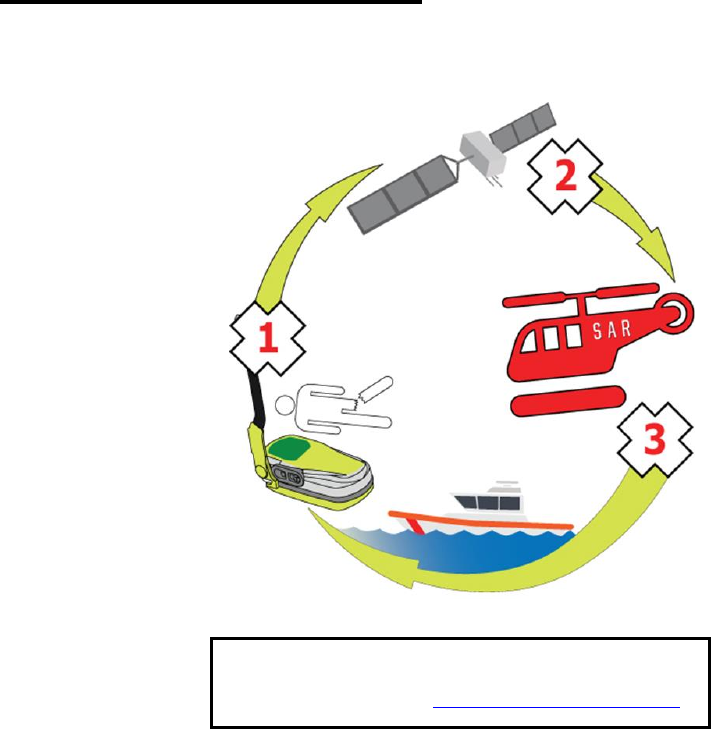
Y1-03-0343 Rev. T1 Company Confidential 7
Anatomy of a Rescue
How the Beacon Works
How your beacon summons help:
406 MHz beacons are a type of portable
emergency equipment that transmits a distress
signal to search and rescue (SAR)
organizations. The purpose of these beacons is
to aid SAR teams in tracking and locating ships
or individuals in jeopardy as rapidly as possible.
The 406 MHz frequency is a worldwide
dedicated emergency frequency that is detected
by a network of satellites called the Cospas-
Sarsat system. This satellite system was
established by, and continues to be supported
by, its primary benefactors – the USA, Russia,
Canada and France. The Cospas-Sarsat system
has saved tens of thousands of lives, and
counting, since its inception.
When a 406 MHz beacon is activated, the
digital distress message is sent to Cospas-
Sarsat satellites and, in turn, the distress
message is relayed to SAR forces via a Rescue
Coordination Centre (RCC). The distress
message contains the beacon UIN and on some models, the GPS location of the beacon.
Additional information about the beacon is accessed by SAR forces from the beacon registration
database. At the same time the 406 MHz signal is activated, a 121.5 MHz signal is turned on.
The 121.5 MHz signal is used by SAR forces to home in on the beacon as they approach it.
The 406 MHz signal is detected by multiple satellites and from that information the location of
the beacon can be calculated. This data alone is sufficient for SAR to find persons or ships in
distress in a reasonable timeframe. However, as a further enhancement, some beacons have a
GPS engine on board (all ACR PLB’s currently manufactured include a GPS engine on board).
This feature allows the beacon to acquire current location coordinates from an internal GPS
receiver. The purpose of this feature is the send an even more precise location of the beacon to
the satellites (i.e., latitude and longitude data). This helps SAR to reach the location even
faster.
Learn more about the Cospas-Sarsat
satellite system: www.cospas-sarsat.org
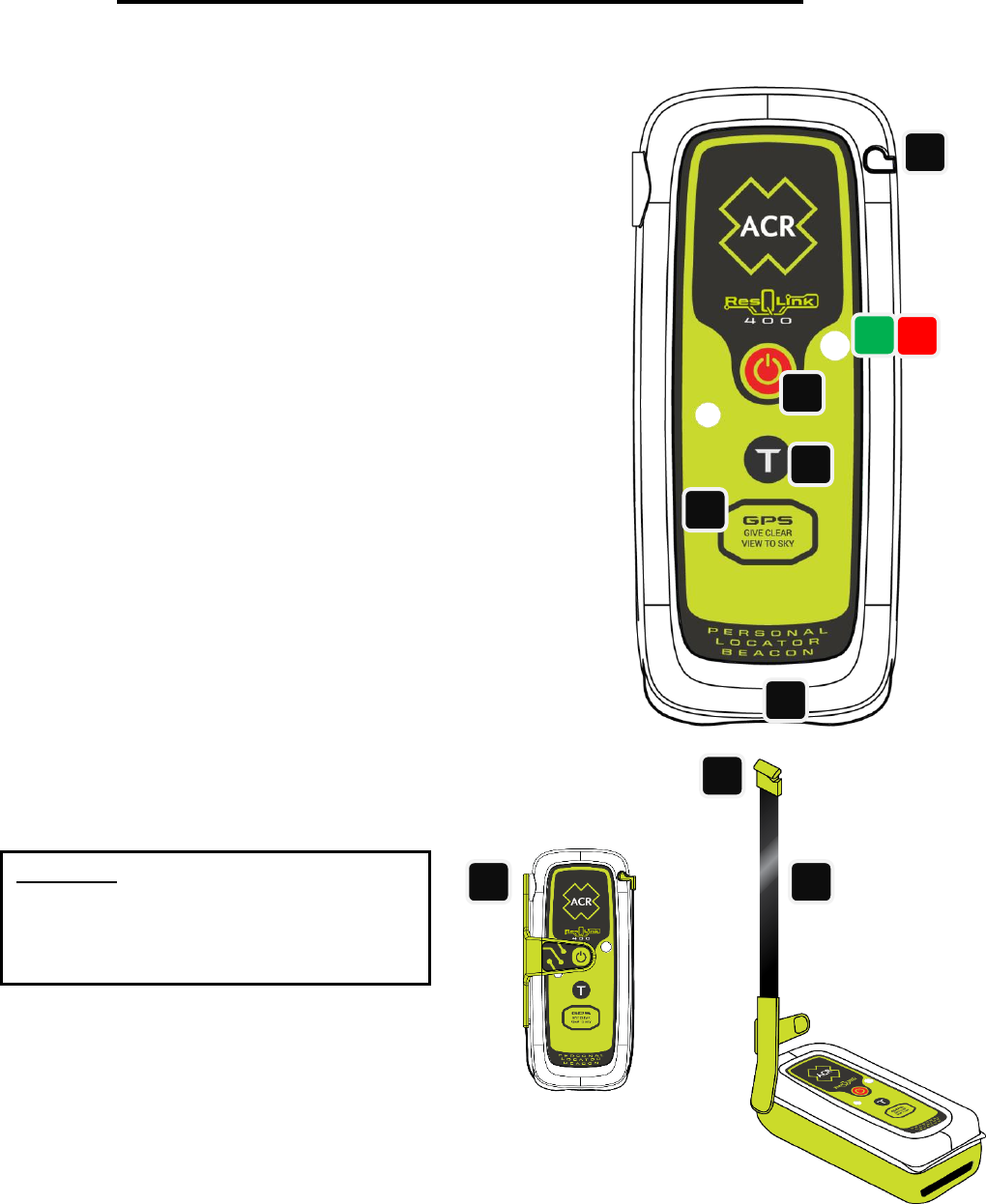
Y1-03-0343 Rev. T1 Company Confidential 8
Anatomy of your Beacon (PLB-400)
Anatomy of your Beacon
A. Antenna Latch – Latch unlocks antenna from the
beacon body. When unclipped, the antenna can be
deployed to uncover ON/OFF button.
B. Strobe Light – Activates when the beacon is turned
on. Facilitates rescue during low-light emergencies.
C. Green LED light – Visual indicator of beacon
activity.
D. Red LED light – Visual indicator of beacon activity.
E. GPS Receiver – Location of GPS receiver, give clear
view to sky and do not obstruct.
F. ON/OFF button – Activates the beacon when
pressed for 2 seconds. Once activated, pressing the
on/off button for 2 seconds again turns the beacon off.
(Button is not accessible until antenna is deployed).
G. TEST button– Activate Self-test or GPS test.
H. Antenna – Wraps around product and protects
ON/OFF button.
WARNING: This transmitter is authorized for
use only during situations of grave and
imminent danger. Deliberate misuse may
incur a severe penalty.
PLB WITH
ANTENNA CLOSED
A
D
C
B
E
F
G
H
H
PLB WITH
ANTENNA
DEPLOYED
A
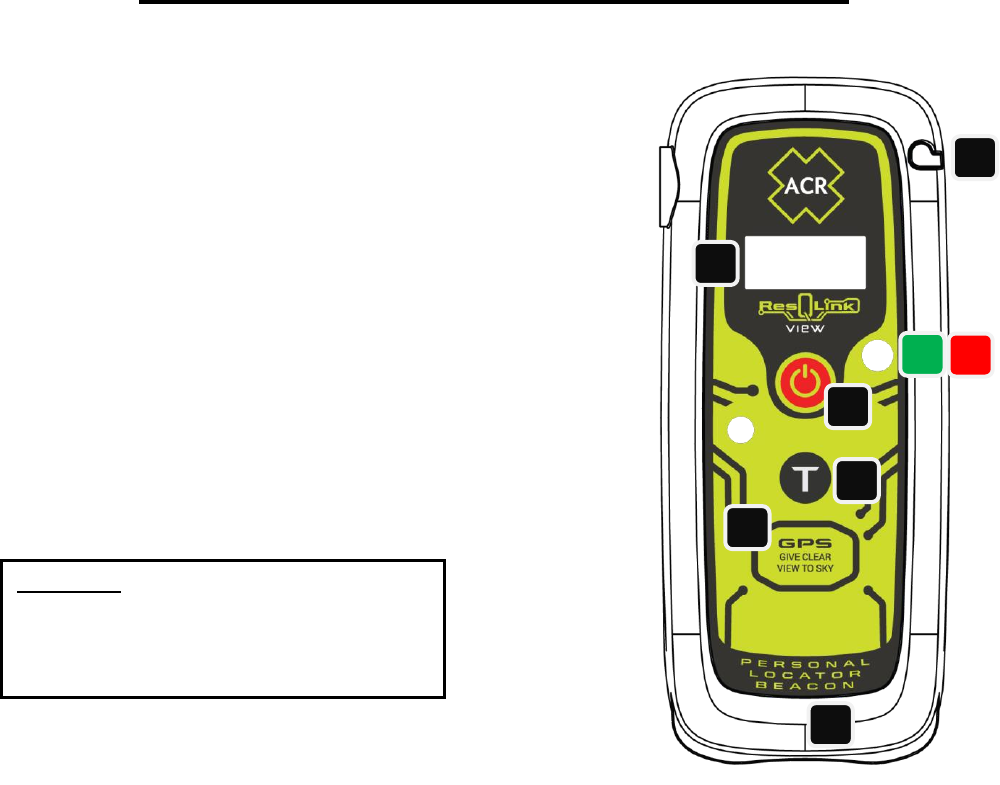
Y1-03-0343 Rev. T1 Company Confidential 9
Anatomy of your Beacon (PLB-425)
Anatomy of your Beacon
The PLB-425 includes all the features (A through H)
marked on the PLB-400 diagram on the previous page.
The PLB-400 and PLB-425 are functionally the same
except the PLB-425 also includes a digital screen as
depicted by letter “I” in the diagram to the right.
Throughout the rest of the manual, beacon images
which include a screen represent the PLB-425 and
images without a screen represent the PLB-400.
WARNING: This transmitter is authorized for
use only during situations of grave and
imminent danger. Deliberate misuse may
incur a severe penalty.
A
D
C
B
E
F
G
I
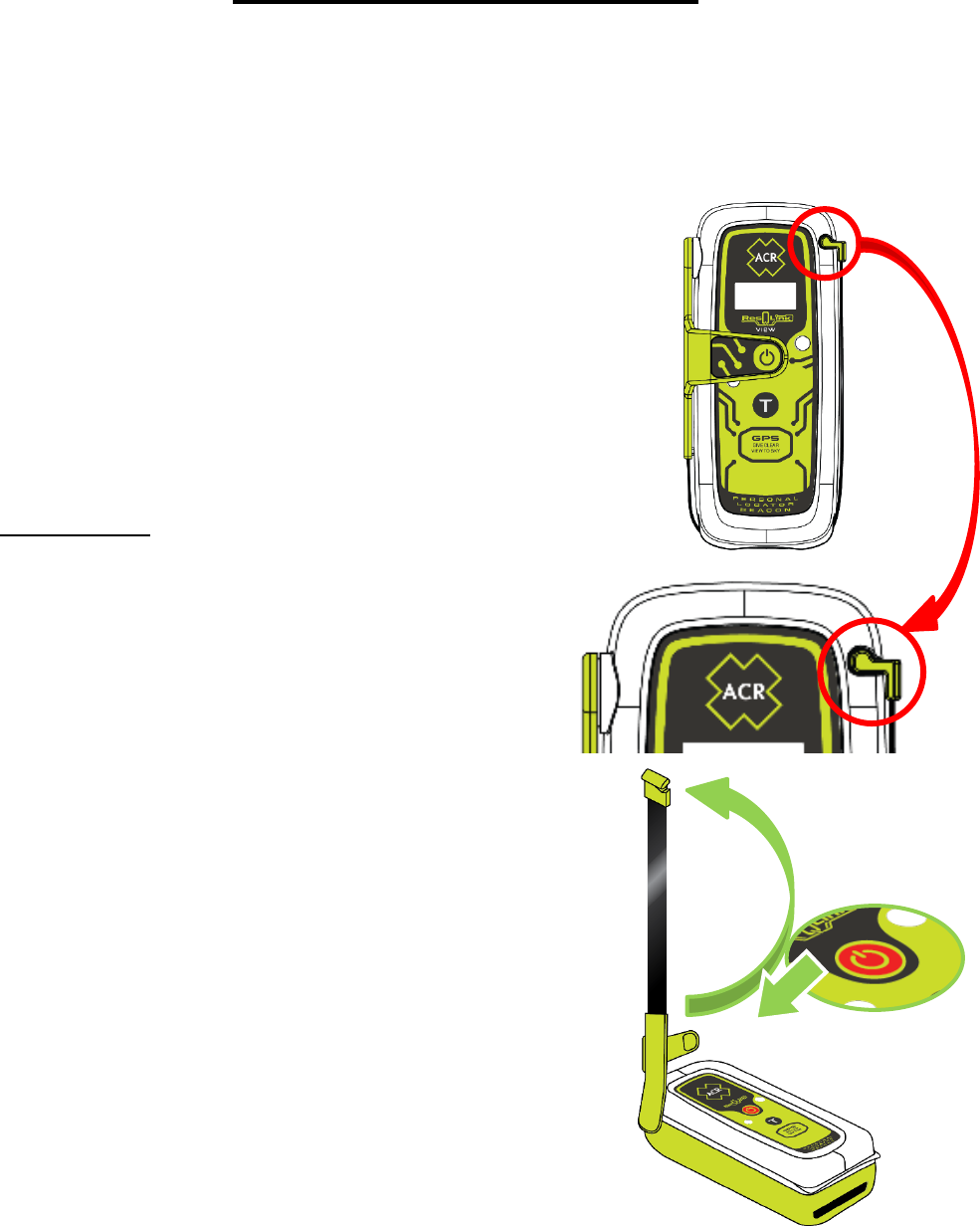
Y1-03-0343 Rev. T1 Company Confidential 10
Activating Your Beacon
Overview
Personal Locator Beacons are designed to be manually activated. They are only to be activated
when all other means of self-rescue have been exhausted. When properly registered as
required, the activation of the beacon tells Search and Rescue who you are, where you are, and
that you are facing a life-threatening situation. Note: Beacon should be activated in open space
with clear view of the sky (eg. Not under any sort of cover or canopy)
How to Activate Your Beacon
To activate your beacon in a distress situation, follow these steps:
1. Unclip the antenna latch from the case and rotate antenna
90 degrees into the upright position. (ON/OFF button will be
exposed on face of beacon once antenna is in upright
position)
2. Depress the ON/OFF button for 2 seconds.
When activated:
The strobe light will flash twice and the red LED will
flash once to let you know the beacon has been
activated. The strobe light and Infrared (IR) strobe light
will both then continue to flash once approximately
every 10 seconds for the entire time the beacon is
activated (Note: The IR strobe is not visible to the
naked eye). The red LED will flash approximately once
every 5 seconds prior to the beacon acquiring your GPS
coordinates.
Once the beacon acquires your GPS coordinates, the
flashing red light will be replaced by a flashing green
light which will flash approximately once every 5
seconds.
When the red light is replaced by the green light, this
indicates that your beacon has successfully acquired
your GPS coordinates and is transmitting them along
with your 406 MHz distress signal.
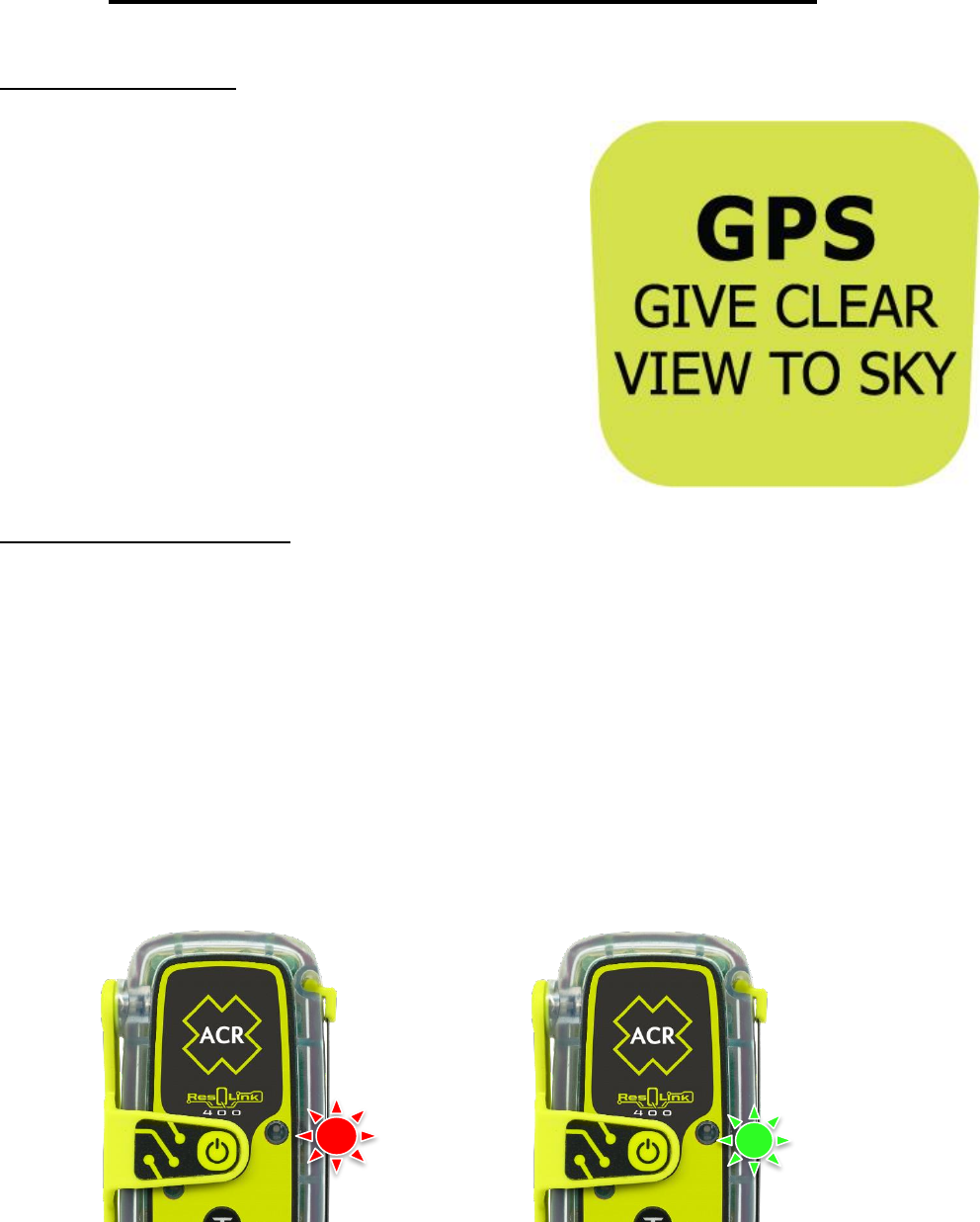
Y1-03-0343 Rev. T1 Company Confidential 11
Activating Your Beacon (continued)
Activation with GPS
When your unit is activated, the GPS receiver will turn on,
search to find your Latitude (LAT) / Longitude (LON), and
incorporate it into your 406 MHz signal.
For the first 6 hours after beacon activation, the internal
GPS will start up every 30 minutes, search to find your
LAT/LON, and incorporate it into your next 406 MHz signal.
If for any reason the internal GPS cannot update your
LAT/LON, your last position will be used for the next four
hours - at that time, the green LED will stop blinking and
the red LED will flash once every 5 seconds until new GPS
data is obtained. Between 6 hours and the end of
operating life (minimum of 24 hours), a GPS location
update is attempted every 60 minutes.
GPS receiver orientation
When activated, it is critical that you do not cover the beacon with any body part, water,
clothing, etc. The GPS receiver is located under the bottom portion of the case where it is
outlined with the text “GPS, Give Clear View to Sky”.
To ensure optimum performance of the GPS receiver, the beacon needs to have an
unobstructed view of the sky. Avoid submerging the GPS receiver in water if possible. Water will
shield and inhibit the GPS receiver and may cause difficulties obtaining your GPS coordinates.
Avoid leaning over the beacon to view blinking LEDs (or blinking LEDs and/or the screen on the
PLB-425 model) as you may shield GPS reception.
Red Flashing Light =
Sending 406 MHz signal
without GPS coordinates
Green Flashing Light =
Sending 406 MHz signal with
GPS coordinates
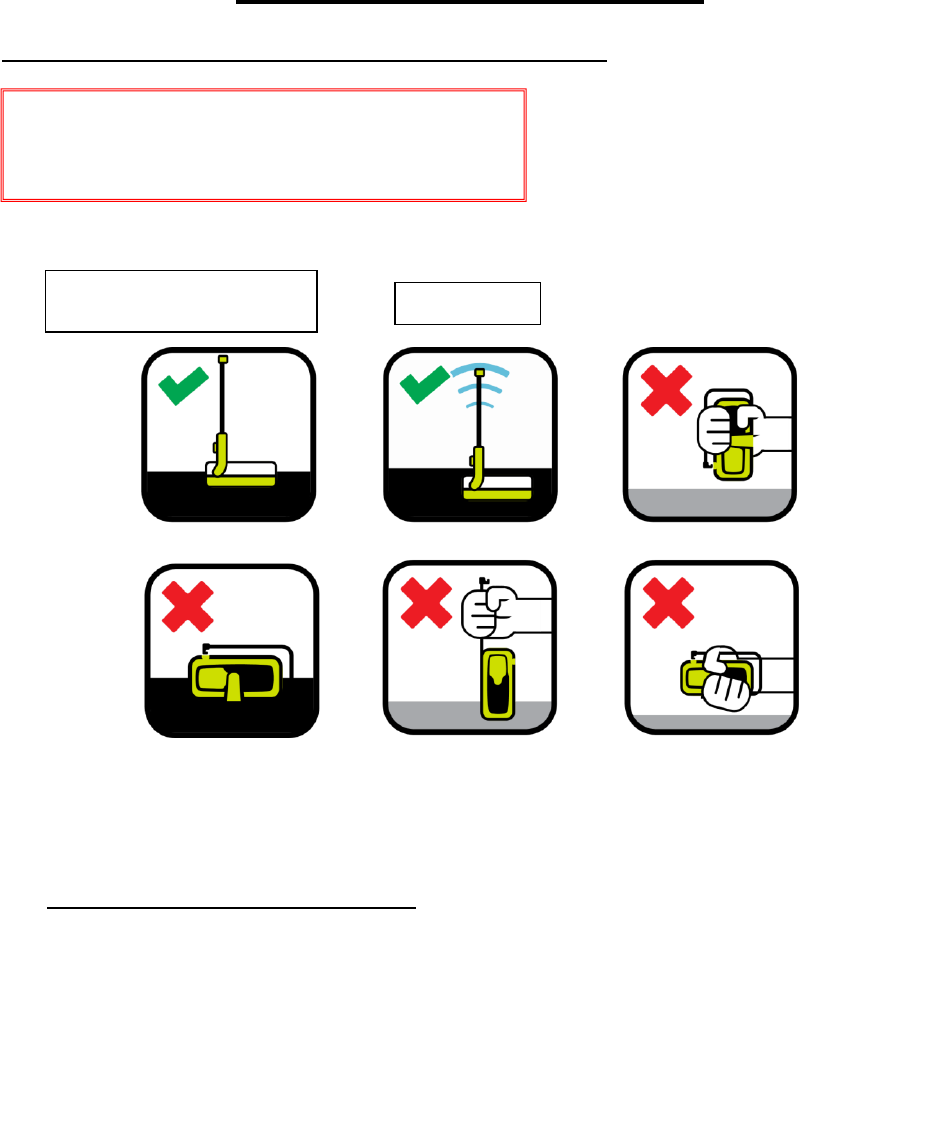
Y1-03-0343 Rev. T1 Company Confidential 12
Activating Your Beacon
Proper Positioning and Handling during Activation
Intended Operational Environments:
Make sure the antenna is pointing towards the sky, out of the water. Beacon is not
intended to operate in water. While the unit is waterproof, it must be above the
water’s surface to function properly.
Intended operational environments include on ground, above ground, and held in
hand. In all cases, the beacon must be facing skyward with the antenna
perpendicular.
Do not cover the GPS receiver with your
hand and make sure you have a clear view
of the sky to ensure GPS is acquired.
Above Ground. Above ground
held in hand is also acceptable
On Ground
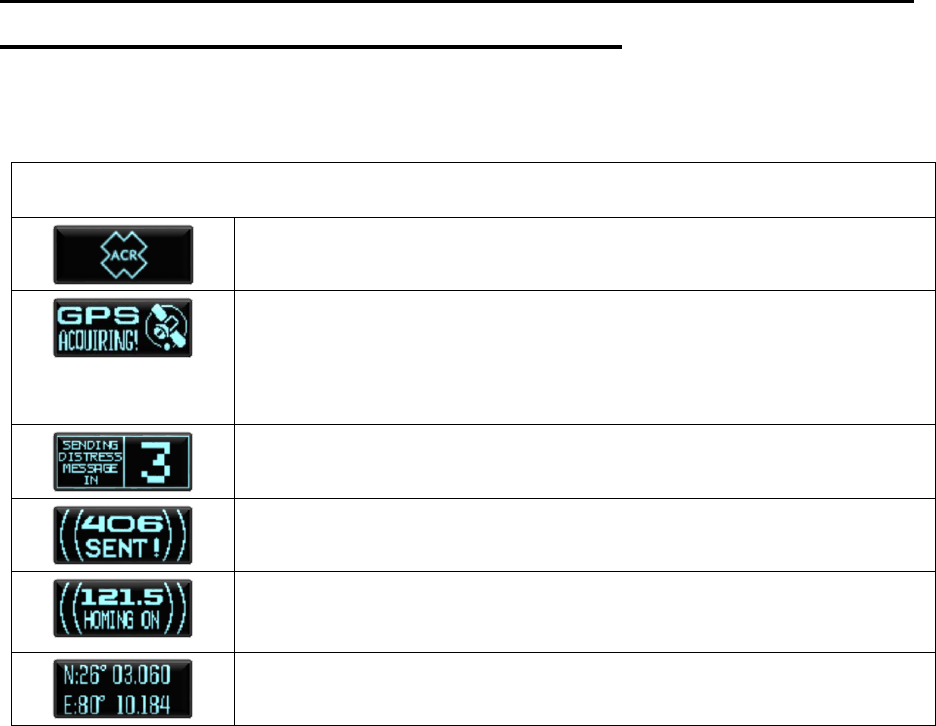
Y1-03-0343 Rev. T1 Company Confidential 13
User Interface: Digital Display during Operation
(specific to PLB-425 model only)
The following table describes the visual feedback on the digital display that the PLB-425
provides during activation.
Digital Display Feedback During Activation
The ACR logo appears indicating the beacon has been activated.
The system reports that it is in the process of acquiring GPS. While
acquiring GPS connection, the system reminds you that for optimum
GPS performance, position the beacon so that it has a clear view of
the sky. It will also recommend other useful operating advise such as,
“Do Not Hold Antenna”.
The system will notify you when it is about to transmit your 406 MHz
emergency distress signal. It will countdown from 3 prior to sending.
You will receive a confirmation message once a 406 MHz Emergency
Signal has been transmitted.
The system reports that the 121.5 MHz homing signal is on. Search
and Rescue (SAR) personnel use this frequency to triangulate your
location when arriving close to the scene.
The system reports recently acquired GPS coordinates.
The beacon will continue to send your distress message for the life of the battery (minimum 24
hours). While valid GPS coordinates are available, the on-screen sequence will reflect the table
above when each distress message is sent. If valid GPS coordinates are not obtained after initial
activation, your distress message will continue to be sent without GPS coordinates until valid
GPS coordinates are obtained. The on-screen sequence when valid GPS coordinates are not
available will reflect the table above, except for the screen showing the GPS coordinates.

Y1-03-0343 Rev. T1 Company Confidential 14
Turning Your Beacon Off
Turning off the beacon
To deactivate your beacon, depress the ON/OFF button for 2 seconds. You will see 2
fast green LED flashes and all blinking LED lights will stop (and the screen will turn off
on the PLB-425 model), signifying that the beacon is no longer sending your distress
message.
NOTE: Leave beacon on until
rescued. Turning the beacon off
will prolong or prevent rescue.
Repeated activations could be
viewed as a hoax.
Hopefully you are never put in the
situation where you have to activate
your beacon to be rescued, however,
should you activate your beacon in an
emergency that requires Search and
Rescue (SAR) assistance, please
contact ACR Electronics, Inc. in the
days that follow.
It is important for us to learn the
nature of your emergency and how
the beacon performed so that we can
continue to build the world’s best
lifesaving equipment.
Real life activations and how people
use our beacons in these situations
plays a major role in designing and
manufacturing our products. We also
like to share these rescues with
others in an effort to promote proper
use of Personal Locator Beacons.
You can learn more about our Post
Rescue Follow Ups by visiting the
Survivor Club section of our website.
Post Rescue Follow Up

Y1-03-0343 Rev. T1 Company Confidential 15
Testing Your Beacon
Your beacon has the ability to perform 2 different tests to ensure that the beacon is working
perfectly. The first is a basic self-test which checks the beacon’s design performance and sends
a self-test message transmitted with default location data. The second is a GPS/GNSS self-test
that turns the GPS receiver on, acquires your position and then transmits this data in a 406 MHz
self-test satellite burst (GPS and GNSS are used interchangeably to describe the GPS/GNSS
Test).
NOTE: Self-test should only be performed in the first 5 minutes of any hour.
Basic Self-Test (No GPS Data)
During a self-test, your beacon will send a 406 MHz signal coded as a self-test to the satellite
system and will also momentarily activate the 121.5 MHz homing signal.
The beacon has enough excess battery life to perform 60 self-tests over the 5 year life of the
battery.
To perform a basic self-test:
1. Unclip the antenna latch from the case and rotate antenna 90 degrees into the upright
position. (ON/OFF button will be exposed on face of beacon once antenna is in upright
position)
2. Depress the Test button between 2 to 5 seconds.
3. A quick flash of the green LED is an indicator that Self-Test was initiated. This will
always be the first LED flash in the self-test sequence.
A green LED will flash to show the start of the Self-Test and will be followed by 3 green LED
flashes (total of 4) and a strobe, indicating a successful Self-Test. The third green LED flash is
an indication that 406 MHz and 121.5 MHz RF was transmitted. The PLB-425 will show this light
sequence and will also flash a message on the screen saying “Self-Test Pass” at the end of the
self-test.
Any red LED flash observed in the above sequence indicates that the beacon has failed self-test.
Repeat the self-test. If the failure persists, contact ACR Electronics, Inc. or an authorized
Battery Replacement Center (BRC) for servicing of your beacon. The PLB-425 will flash a
message saying “Self-Test Fail” at the end of a failed self-test.
ACR strongly recommends performing the self-test once per month, or at least two weeks
prior to a trip, allowing enough time for service should your beacon require it. Do not exceed
the self-test limit to ensure confidence in the operation of the PLB for greater than 24 hours.
Low Battery Indicator during Self-Test
If the total ON time of the beacon exceeds 2 hours, there will be 3 green LED
flashes followed by 2 red LED flashes. In addition to the LED indicators, the display
on the PLB-425 will indicate a “Self-Test Fail” and will show a low battery warning.
While the beacon may still operate normally in a distress situation, ACR strongly
recommends you have your battery replaced to ensure that you will have at least
24 hours of battery power in an emergency.
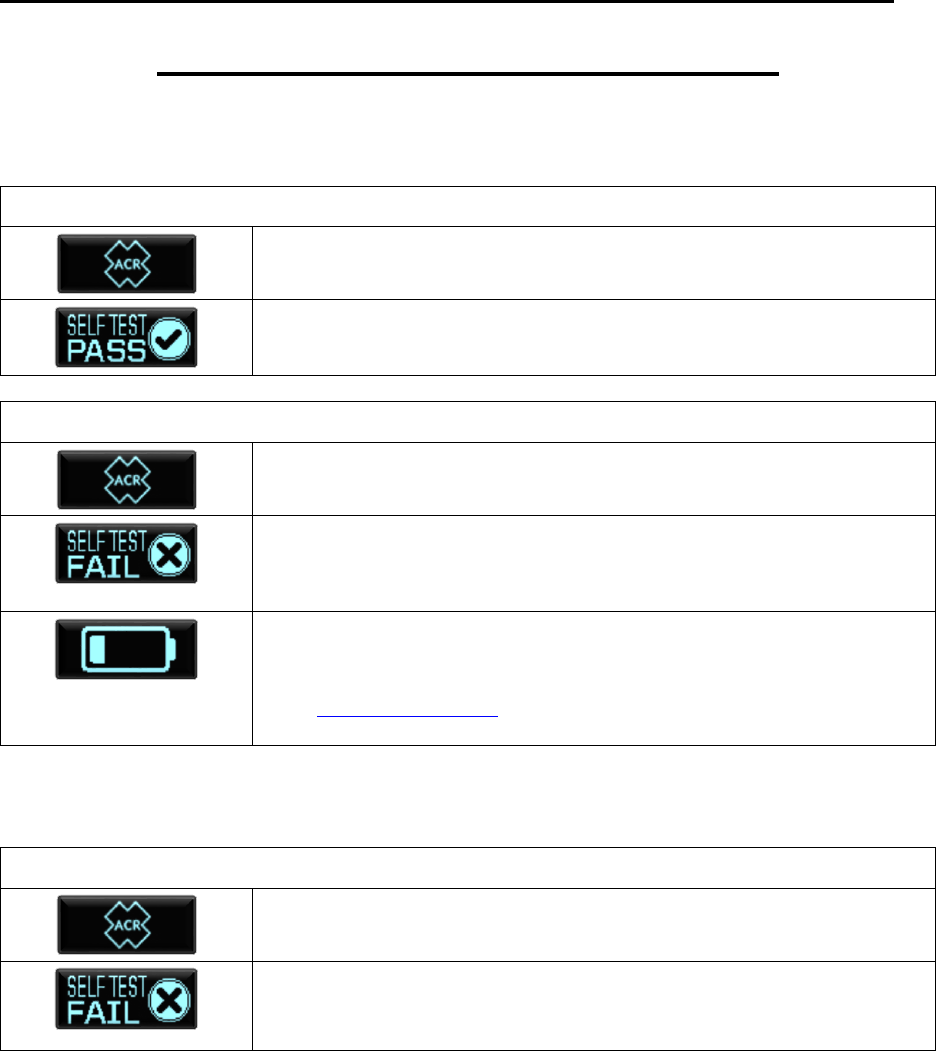
Y1-03-0343 Rev. T1 Company Confidential 16
User Interface: Digital Display during Self-Test
(specific to PLB-425 model only)
The following table describes the visual feedback on the digital display that the PLB-425
provides during a Self-Test.
Digital Display Feedback During a Passed Self-Test
The ACR logo appears indicating that the Beacon Self-Test has
been initiated.
The system performs a thorough testing of the beacon’s
functionality and all tests pass.
Digital Display Feedback When Battery is Low
Beacon Self-Test has been initiated, and the ACR Electronics
Welcome Page appears.
The system checks the duration of battery usage. If more than two
hours of battery life have been used, this Self-Test Fail message is
displayed.
The system provides a low battery warning indicating that the
beacon is due for a battery replacement. The battery can be
replaced by ACR or an ACR Authorized Battery Replacement Center
(visit www.acrartex.com and select the “Dealer Locator” option in
the “Support” section of the site to find an authorized dealer).
Digital Display Feedback During a Failed Self-Test
Beacon Self-Test has been initiated, and the ACR Electronics
Welcome Page appears.
The system performs a thorough testing of the beacon’s
functionality and displays this message if any of the tests fail. The
beacon should be returned to ACR Electronics.

Y1-03-0343 Rev. T1 Company Confidential 17
Testing Your Beacon
GPS Self-Test (GNSS Self-Test)
The GPS receiver is located under the bottom front portion of the case (indicated by “GPS Give
Clear View to Sky”). It is imperative that the receiver is not obstructed during the GPS self-test
or during activation to ensure that the GPS receiver is acquiring your latitude (LAT) and
longitude (LON) position. This test must be performed outside with a clear view of the sky.
This beacon has enough excess battery life to perform 20 GPS self-tests over the 5 year life of
the battery. Once this GPS testing feature reaches 20 tests, the feature will be disabled by
internal software.
To perform a GPS self-test:
1. Unclip the antenna latch from the case and rotate antenna 90 degrees into the upright
position. (ON/OFF button will be exposed on face of beacon once antenna is in upright
position).
2. Depress the “Test” button between 5 and 10 seconds.
A green LED will flash to show the start of the GPS test and will be followed by 3 quick green LED
flashes. Subsequent red LED flashes will occur approximately every 5 seconds until GPS has been
acquired by the beacon. Once valid GPS data has been obtained, a green LED flash and a strobe,
indicates a successful GPS self-test. As long as the beacon is unable to acquire GPS coordinates,
the beacon will continue flashing the red LED for no longer than 110 seconds and then terminate
GPS self-test, indicating a failed GPS self-test. In case of a failed GPS self-test, repeat GPS self-
test and if failure persists, return the beacon to ACR Electronics, Inc. for service. The PLB-400
and PLB-425 will both display the same LED sequences but the PLB-425 will also display the
following 3 things on the screen to show a passed GPS Test: GPS Coordinates, “GPS Test Pass,”
and the total number of GPS tests remaining that the beacon is able to run. In the event of a
failed GPS Test, the PLB-425 will display the following on the screen: “GPS Test Fail” followed by
the total number of GPS tests remaining that the beacon is able to run.
The maximum number of GPS tests allowed is 20. If the user tries to perform another GPS test
after the maximum of 20 has been reached, there will be a green LED flash, followed by 3 quick
green LED flashes, followed by 3 red LED flashes and the beacon will then turn off (in addition to
the 3 red LED flashes, the PLB-425 will display a message on the screen indicating that the GPS
Test Limit has been reached). Additionally, if the total ON time of the beacon exceeds 2 hours,
the beacon will not allow any more GPS tests to run.
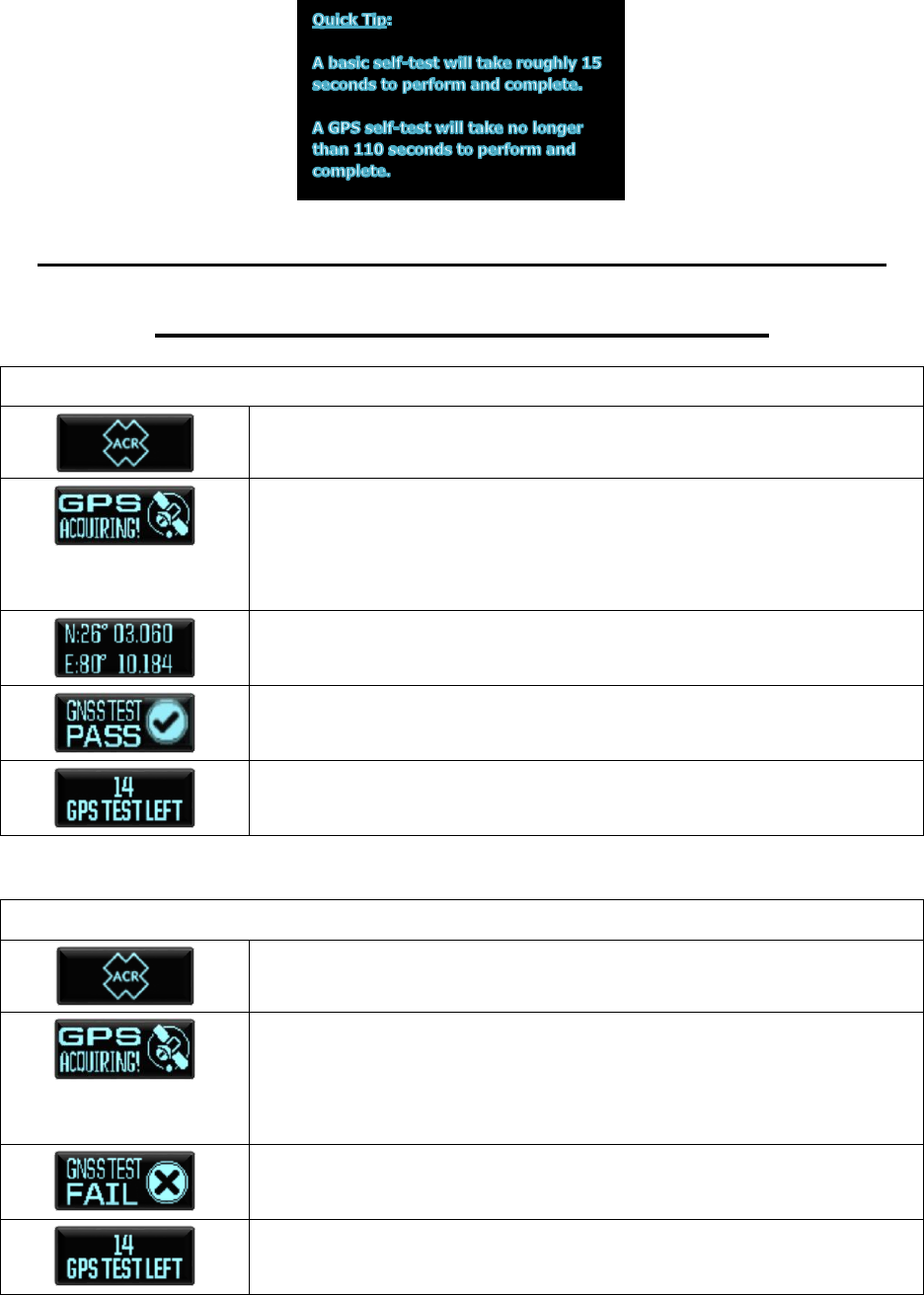
Y1-03-0343 Rev. T1 Company Confidential 18
User Interface: Digital Display during GPS/GNSS Test
(specific to PLB-425 model only)
Digital Display Feedback During a Passed GPS/GNSS Test
The ACR logo appears indicating that the beacon GPS/GNSS Test
has been initiated.
The system reports that it is in the process of acquiring GPS. While
acquiring GPS connection, the system reminds you that for
optimum GPS performance, position the beacon so that it has a
clear view of the sky. It will also recommend other useful operating
advise such as, “Do Not Hold Antenna”.
The systems acquires your GPS coordinates and displays them.
The system confirms that it has passed the test.
The system will report the remaining number of GPS/GNSS Tests
available.
Digital Display Feedback During a Failed GPS/GNSS Test
Beacon GPS/GNSS Test has been initiated, and the ACR Electronics
Welcome Page appears.
The system reports that it is in the process of acquiring GPS. While
acquiring GPS connection, the system reminds you that for
optimum GPS performance, position the beacon so that it has a
clear view of the sky. It will also recommend other useful operating
advise such as, “Do Not Hold Antenna”.
The system will notify you that it has failed the test.
The system will end with the remaining amounts of GPS/GNSS
Tests available.

Y1-03-0343 Rev. T1 Company Confidential 19
Satellite Testing Your Beacon
Optional Advanced through Satellite Testing and Beacon Management
Additional features and through satellite testing services are available for this beacon when you
subscribe to www.406Link.com.
When you sign up for this optional service you can test your beacon and have confirmation
messages sent to your cell phone or email. Visit 406Link.com for complete details. (This service
is not required for your beacon to function as a Personal Locator Beacon.)
Service limited to North and South America. See coverage map at www.406Link.com.
False Alarms
Preventing False Alerts
A false alert is any activation of the beacon, intentional or otherwise, that does not result from
a situation of grave and imminent danger. Be sure to do the following to help minimize false
alerts:
Register your Beacon
This does not reduce false alerts; however, when the beacon is properly registered, the
situation can usually be resolved with a phone call.
Keep Track of your Beacon
When not in your possession, be careful with whom you leave your beacon. Make sure they
know how to use it, and that they understand the ramifications of causing a false alert. A lot of
false alerts are generated by curious individuals. If you notice the beacon is flashing the red or
green LED and strobing periodically on its own, this likely means it has accidentally been
activated and needs to be shut off and reported.
NOTE: If you report a false alert and the authorities have not received the signal, do not
be concerned. This may mean that you were able to deactivate the beacon before the
signal was transmitted.

Y1-03-0343 Rev. T1 Company Confidential 20
False Alert
A 406 MHz false alert MUST be reported to the search and rescue authorities.
To report a 406 MHz false alert in the United States, contact:
United States Air force Rescue Coordination Center (AFRCC)
Telephone: 1-800-851-3051
To report a false alert outside of the United States, contact the national authority
where your beacon is registered. False alerts in Canada, notify the Canadian Mission Control
Center by calling 1-800-211-8107. False alerts in Australia, inform the Australian Maritime
Safety Authority, Joint Rescue Coordination Centre (JRCC Australia) and false alerts in New
Zealand, inform the Rescue Coordination Centre New Zealand (RCCNZ).
Reporting
Should there be a false alert for any reason, it must be reported to the nearest search and rescue
authorities. The information that should be reported includes:
• The PLB’s 15-digit Unique Identifier Number (UIN). Also identified as the 15-digit Hex ID
• Time and date
• Duration and cause of activation
• Location of beacon at the time of activation
Beacon Maintenance
Routine Maintenance
Carefully inspect the beacon case for any visible cracks. Cracks may admit moisture, which
could falsely activate the beacon or otherwise cause a malfunction. Any cracks observed should
be immediately referred to ACR for evaluation by calling +1 (954) 862-2110. ACR Technical
Support can also be reached by sending an email to: service@acrartex.com.
After checking the beacon for cracks, it may be wiped down with a clean, damp cloth. Do not
use any type of cleaner on your beacon.

Y1-03-0343 Rev. T1 Company Confidential 21
Battery Replacement
Replace the battery no later than the battery expiration date specified on the beacon, or after
emergency use. At each inspection, check the time remaining until replacement is required. The
battery should be replaced if the beacon has been activated for any use other than the self-
test/GPS test. Always refer battery replacements and other beacon service to a factory
authorized Battery Replacement Center.
NOTE: There are no user serviceable items inside the beacon. DO NOT OPEN THE BEACON.
Opening the beacon will void the warranty.
For the nearest location of a Battery Replacement Center, visit our website and utilize the
Dealer Locator feature located in the Support section of the site.
Beacon Transport
This beacon contains 1 lithium metal battery pack that is less than 0.8 grams. The beacon is not
classified as HAZMAT for transportation. Prior to shipping the beacon for service, alert your
carriers about the batteries contained in this equipment to make sure they properly label your
package. Call ACR’s Technical Service department at +1 (954) 862-2110 for proper shipping
instructions or visit the ACR website for an MSDS.
• Always pack your PLB in a stout cardboard carton. ACR advises that you keep the
original packaging in case of return for service
• For surface transport the PLB may be shipped ‘excepted’ under special provision 188
• For air transport the PLB should be shipped as category UN3091 and packed under IATA
packing instruction 970 section II.
Changing ownership or contact information
As the owner of the beacon, it is your responsibility to advise the national authority of any
change in your registration information. If you are transferring the beacon to a new owner, you
are required to inform the national authority. You can do this by using their online database or
by letter, fax or telephone and informing the authority of the name and address of the new
owner.
The new owner of the beacon is required to provide the national authority with all of the
information requested on the registration form. This obligation transfers to all subsequent
owners.

Y1-03-0343 Rev. T1 Company Confidential 22
Lost or Stolen PLBs
If your PLB is lost or stolen, do the following immediately:
• Report to your local authorities that the PLB has been lost or stolen.
• Contact your National Authority with the following information:
➢ Police department name
➢ Police department phone number
➢ Police case number
If your PLB were to be activated, the information you provided will be forwarded to the
appropriate search and rescue authorities who will ensure that your PLB gets back to you.
If someone attempts to register a PLB reported as stolen, your national authority will notify the
appropriate police department.
Product Specifications
General/Environmental
Product Number
2921
Model Number
PLB-400
Beacon model hardware part
number
A3-06-3138-1
Size
4.52 (L) x 2.03 (W) x 1.49” (D)
Weight
5.2 oz. (148 g)
Buoyancy
Category 1, Buoyant
The ResQLink 400 is a buoyant PLB but is not intended for operation in
water. Intended operational environments include on ground and above
ground including held in hand. In all cases, the beacon must be facing
skyward with the antenna perpendicular.
Product Number
2922
Model number
PLB-425
Beacon model hardware part
number
A3-06-3138-
Size
4.52 (L) x 2.03 (W) x 1.49” (D)

Y1-03-0343 Rev. T1 Company Confidential 23
Weight
5.3 oz. (151 g)
Buoyancy
Category 1, buoyant
The ResQLink View is a buoyant PLB but is not intended for operation in
water. Intended operational environments include on ground and above
ground including held in hand. In all cases, the beacon must be facing
skyward with the antenna perpendicular.
Material
High impact and UV resistant plastic
Color
ACR-treuse™ (high visibility yellow)
Strobe
Bright white, one flash per ten seconds
Activation
Manual
Operation
2 steps: deploy antenna, press ON button. Give clear view
to sky.
Waterproof
16.40 ft. (5m) @ 1 hr., 33 ft. (10m) @ 10 min.
Factory tested @70° F, exceeds RTCM waterproof
requirements.
Approvals
Pending: Cospas-Sarsat, FCC, RED (R&TTE), Canada, AMSA
PLB-400/425 meets the requirements of Federal
Communications Commission (FCC) Part 95 Subpart K.
For all other types of approval information, please visit
www.acrartex.com.
Limited Warranty
5 years
Lead Free
Yes
Battery
Batteries meet the UN Classification for non-dangerous goods.
Class
Class 2 (non-hazmat) lithium batteries
Battery Replacement
Replace battery by due date specified on the unit
(five (5) years from date of installation of battery in
the beacon) or after emergency use.
Battery Life
Five (5) years
Operational Life
Minimum 24 hours @ -4°F/-20°C to +131°F/+55°C
406 MHz Transmitter
Frequency
406.031 MHz
Output Power
5+ Watts
Stability
2 ppb/100ms

Y1-03-0343 Rev. T1 Company Confidential 24
Modulation
Type
Phase (16K0G1D)
Digital Message
Format
144 bits
Long Message
Serialized
Beacons are shipped from ACR with a serialized code but can be
reprogrammed at a service center to other coded formats including
nationality of registration.
Message Protocol
Standard Location and National Location
Duration
520 ms
Rate
400 bps
Encoding
Biphase L
Modulation
+1.1 radians peak
121.5 MHz Transmitter
Frequency
121.5 MHz
Tolerance
+50 ppm
Output Power
>25mW PEP (typical 79mW) (17 dBm)
Morse Code “P” ID
Approximately every 50 seconds (U.S. protocol)
Temperature Range
Operating
-4°F/-20°C to +131°F/+55°C
Storage
-22°F/-30°C to +158°F/+70°C
Modulation
Type
AM (3K20A3X)
Sweep Range
500 to 1600 Hz
Sweep Rate
4 Hz
Duty Cycle
33.3%
Morse P
AM (2K00A2A)
Antenna
Frequency
406.031 MHz and 121.5 MHz
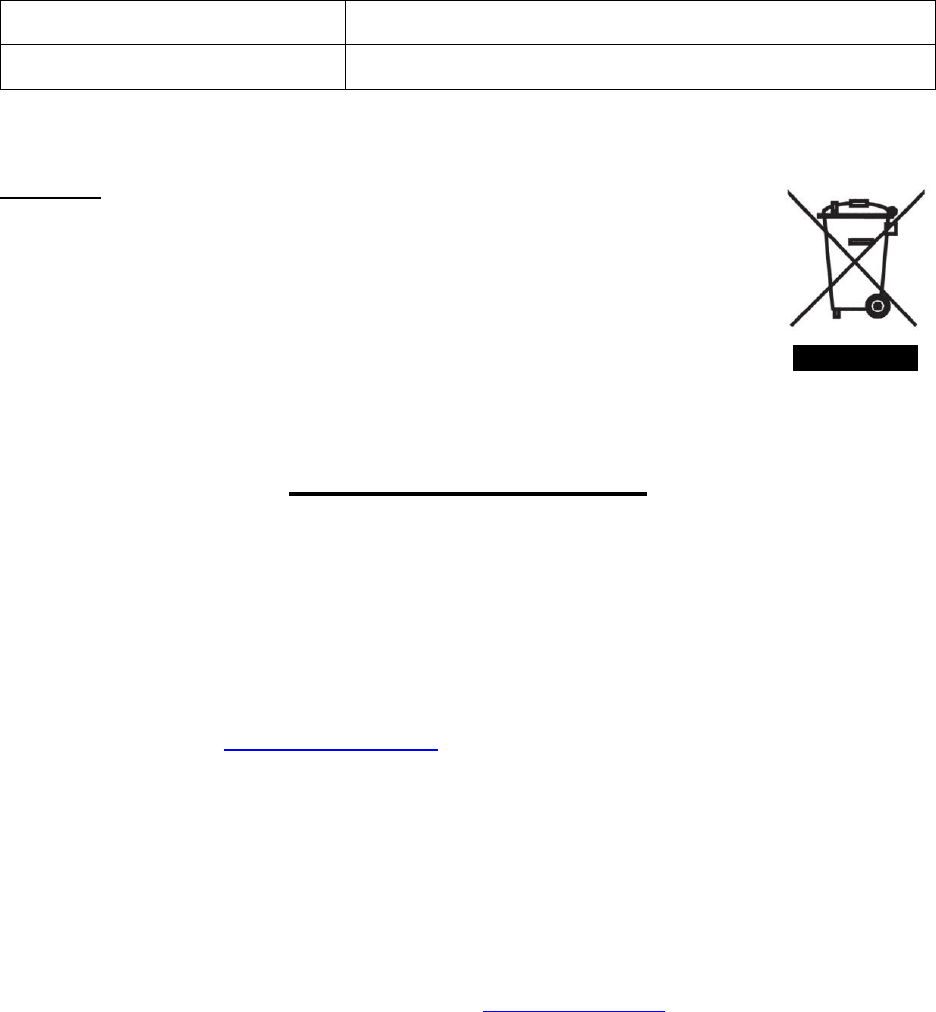
Y1-03-0343 Rev. T1 Company Confidential 25
Polarization
Vertical
VSWR
Less than 1.5:1
CAUTION: Contains lithium batteries. Do not incinerate, puncture,
deform, short-circuit or recharge. Do not dismantle the PLB, contains
no user-serviceable parts. Dispose of the used PLB with the battery
removed in accordance with local waste disposal regulations.
Product Warranty
Limited Warranty
This product is warranted against factory defects in material and workmanship for a period of
five years* from date of purchase or receipt as a gift. During the warranty period, ACR
Electronics, Inc. will repair or, at its option, replace the unit at no cost to you for labor,
materials and return transportation from ACR. For further assistance, please email our Technical
Service Department at service@acrartex.com or telephone at +1 (954) 862-2110.
This warranty does not apply if the product has been damaged by accident or misuse, or as a
result of service or modification performed by an unauthorized factory. Except as otherwise
expressly stated in the previous paragraph, THE COMPANY MAKES NO REPRESENTATION OR
WARRANTY OF ANY KIND, EXPRESS OR IMPLIED, AS TO MERCHANTABILITY, FITNESS FOR A
PARTICULAR PURPOSE, OR ANY OTHER MATTER WITH RESPECT TO THIS PRODUCT. The
Company shall not be liable for consequential or special damages.
To place the warranty in effect, register online at www.acrartex.com.
* Five years for the following products: EPIRB and PLB.